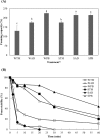Technical Functional Properties of Water- and Salt-soluble Proteins Extracted from Edible Insects
- PMID: 31508594
- PMCID: PMC6728818
- DOI: 10.5851/kosfa.2019.e56
Technical Functional Properties of Water- and Salt-soluble Proteins Extracted from Edible Insects
Abstract
The amino acid composition, protein quality, and protein functionality of protein solution extracted from three edible insect species were investigated. We used 0.02% ascorbic acid and 0.58 M saline solution to extract water-soluble and salt-soluble proteins from the three insect species. Extracted protein solutions of Tenebrio molitor (TM), Allomyrina dichotoma (AD), and Protaetia brevitarsis seulensis (PB) were divided into six groups, according to species and solubility: WTM, WAD, WPB (water-soluble), and STM, SAD, and SPB (salt-soluble). Defatted TM had the highest protein content, but its protein solubility was the lowest, for both water and saline solutions. Amino acid composition differed by edible insect species and buffer type; SPB had the highest protein quality, followed by WPB. PB had a higher pH than the other species. Color values also differed among species. SPB had abundant high molecular weight proteins, compared with other treatments; and also had the highest foaming capacity, foam stability, and emulsifying capacity. In conclusion, PB is a good source of functional protein compared with the other studied species. Additionally, protein extraction using saline solution is promising as a useful method for improving edible insect protein functionality.
Keywords: edible insects; protein functionality; protein quality; salt-soluble; water-soluble.
Conflict of interest statement
Conflicts of Interest The authors declare no potential conflict of interest.
Figures



References
-
- AOAC . Official methods of analysis of AOAC International. 17th ed. Association of Official Analytical Chemists; Gaithersburg, MD, USA: 2000.
-
- Atkinson PW, Brown WV, Gilby AR. Phenolic compounds from insect cuticle: Identification of some lipid antioxidants. Insect Biochem. 1973;3:309–315. doi: 10.1016/0020-1790(73)90062-0. - DOI
-
- Caparros Megido R, Poelaert C, Ernens M, Liotta M, Blecker C, Danthine S, Tyteca E, Haubruge E, Alabi T, Bindelle J, Francis F. Effect of household cooking techniques on the microbiological load and the nutritional quality of mealworms (Tenebrio molitor L. 1758) Food Res Int. 2018;106:503–508. doi: 10.1016/j.foodres.2018.01.002. - DOI - PubMed
LinkOut - more resources
Full Text Sources
Other Literature Sources

